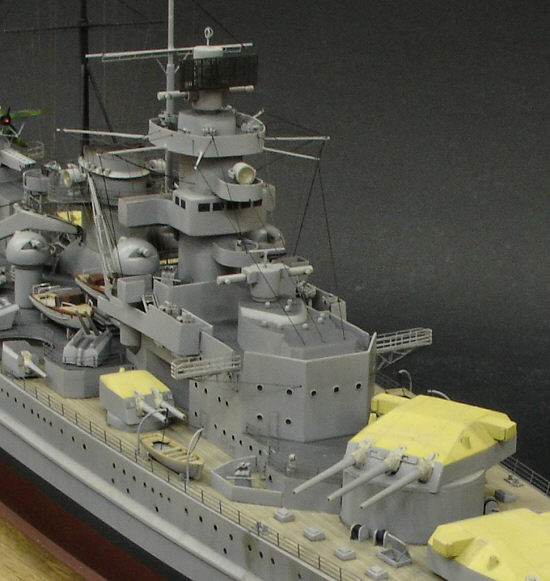Detailing Heller’s 1/400 Gneisenau
by Ulf Lundberg
English translation by Martin Waligorski
| Note for Swedish readers |
| Den här artikeln finns även tillgänglig på svenska i form av ett PDF-fil, 435 KB |
Painting
The hull, superstructure and all the subassemblies were washed with white spirit and then primed with a coat of Gunze Mr Primer. For the painting I used Vallejo acrylics. All painting was done by airbrush unless stated otherwise.
 The last moment when the extent of my detailing work is clearly visible: all details are in place and the model ready for painting.
The last moment when the extent of my detailing work is clearly visible: all details are in place and the model ready for painting.
The Wooden Deck
After some experimentation with colours, masking and pre-shading, I settled on a method of painting the entire deck in uniform base colour, then enhancing individual planks in varying shades. To produce the different wood shades, I mixed light grey, brown and sand yellow to a scale of four gradually lighter shades and then proceeded as follows.
After the first uniform coat of paint, individual planks covering about 1/4 of the deck area are were masked using pieces of masking tape measuring 1 x 16 mm in size. Then the deck was airbrushed in a lighter shade and left overnight to dry. After than I masked another 1/4 of the deck area and repeated the process, then repeated everything twice more. The process was tedious, each masking session lasting for about an hour. Then there was time to remove masks, which inevitably lead to some unwanted chipping and scratches, not least caused by the edge of the knife used to lift off the tape pieces. However, these blemishes could be satisfactorily corrected with a brush.
Disaster struck when, according to my plan, I went about dry-brushing the deck to enhance its structure. Despite my best effort this produced only a sticky mess. I tried to remedy the situation by lightly spraying the deck with a light wood shade, but it didn’t do much help. Sorry and frustrated, I put the entire model aside. After a few days of deliberation, I came to terms with the insight that I’d have to start all over again. I mustered all my courage and patience, but managed to hold out and this time achieve a satisfactory result which I was very pleased with.
Inspired by this success, I produced masks for swastika recognition marks at the bow and the stern. They were simply templates cut out from a plastic sheet coming from a cottage cheese packaging. The insignia were painted, the entire deck covered with a coat of matt varnish and after all I finally felt quite content with the achieved result.
More Painting and Weathering
The painting continued witch masking out the wooden deck and airbrushing the hull sides and superstructure. This was started by pre-shading in a quite random pattern followed by a coat of light grey.
At this stage it became painfully obvious that the paint job would take time – a lot of time – to complete. At every stage of painting I discovered something that needed adjustment – be it flaws in my previous sanding work, details to be improved or chips of paint coming off with masking tape.
This was definitely the most psychologically challenging part of the project, and one that tested the limits of my perseverance. On the other hand, experience says that every modelling project has a difficult period, after the initial enthusiasm has faded off and the end result is not yet recognisable among all the the subassemblies. I think that one just needs to endure through this phase. Usually, the rewarding feeling which returns as the beautiful model gradually emerges more than compensates for these difficulties.
Back to the subject of painting, upper decks were covered with a coat of dark grey. I painted the roofs of main gun turrets with a mixture of faded yellow. I painter the photoetched rails in Neutral Grey, somewhat darker than other vertical surfaces in order to make them ”disappear” better and therefore enhance their finesse.
The flat black soot residue on the stack was airbrushed.
Then the hull was masked along the waterline and its bottom painted using multiple shades of red-brown obtained by mixing Hull Red, Flat Earth and Bright Red in different proportions.
I wanted to add traces of algae growth on the hull and my first attempt was to airbrush a dirty green mix here and there in broad strokes. This resulted in rather unimpressive and too uniform dark shading, so I repainted the area in red and instead used a brown wash stippled in the appropriate places wit the tip of the brush.
The waterline was painted Black Grey. The shading and patches of dirt at the hull sides were then simulated with a wash of artist’s oils diluted with white spirit.
To complete the weathering process, all superstructure details were dry-brushed with a lighter shade of grey.
On Thursday 17 February 2005 just after 2300 hours, after a long finishing session, she was ready, just in time to pack for the IPMS Norway nationals in Oslo. Well, not entirely: the Arado Ar 196 seaplane was added only about a month later.
Go to Part1: Contruction
(During its first public presentation at IPMS Norway’s Landskonkurranse 2005, this model was awarded the prestigious Best in Show award – Ed.)
This article was originally published in IPMS stockholm Magazine in June 2006







